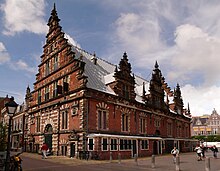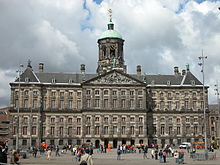Architecture of the Netherlands
This article relies largely or entirely on a single source. (November 2018) |

Dutch architecture has played an important role in the international discourse on architecture in three eras. The first of these was during the 17th century, when the
Examples
Renaissance and Baroque

The Dutch Golden Age roughly spanned the 17th century.[1] Due to the thriving economy, cities expanded greatly. New town halls and storehouses were built, and many new canals were dug out in and around various cities such as Delft, Leiden, and Amsterdam for defense and transport purposes. Many wealthy merchants had new houses built along these canals. These houses were generally very narrow and had ornamented façades that befitted their new status. In the countryside, new country houses were built, though not in the same numbers.
Of
The architecture of the first republic in Northern Europe was marked by sobriety and restraint, and was meant to reflect democratic values by quoting extensively from

The major exponents of the mid-17th century,
Another of the designs used by the Dutch was the use of warm colors such as red or dark orange. They also were roughly textured and had tended to be darkened due to the rough texturing. The use of architectural symmetrical balance was part of their habits as well.
Modernism

During the 20th century, Dutch architects like
Crucial for the development of modern architecture in the Netherlands has been the work of Hendrik Petrus Berlage, architect of the Beurs van Berlage. He propagated Rationalist architecture, while simultaneously embracing craftsmanship.[6] Berlage has also received critical acclaim for Plan Zuid, an urban plan for Amsterdam-Zuid,[7] which became a model for social housing developments in the Netherlands and abroad.[8] Berlage inspired different movements, and different groups and schools were established accordingly, during the 1910s-1930s, each with their own view on which direction modern architecture should take.
- Expressionist architects like Michel de Klerk and Piet Kramer were associated with the Amsterdam School, a modern movement that emphasized the importance of craftsmanship.[9] A direct relationship can be observed in Plan Zuid.
- Another group established J.J.P. Oud, Jan Wils, and Gerrit Rietveld. These architects would later build in a functionalist style.
- A third group, partly developing out of De Stijl, consisted of CIAM. Berlage, however, criticized this movement for its lack of emotion.[11] It was nevertheless very influential, also, and especially after WWII, in both architecture and town planning, through the work of, among other, Lotte Stam-Beese and Cornelis van Eesteren. Their work also informed planning theory and practice abroad.
- A more traditionalist current also developed out of Berlage's architecture, especially taking inspiration from its crafsmenship. This developed into the Delftse School, headed by Marinus Jan Granpré Molière. Traditionalist architects rejected the main (industrial) principles of functionalism, and came to the fore in the 1930s. As a movement, traditionalist architecture lasted until well after 1945.
Several cross-connections existed between the schools and movements, as can be observed in the work of Willem Dudok; some of his designs have traditionalist features, while others are landmarks of functionalism. In the (late) 1930s, various modern architects advocated a return to (certain) traditional artistic principles, instead of following a machine aesthetics, among them J.J.P Oud and Sybold van Ravesteyn,[12] although the reverse happened as well, especially in the 1950s-1960s (e.g. J.F. Berghoef[13]). The different movements and schools, together with their disputes, would inform the development of Dutch architecture in the second half of the 20th century,[14] which also witnessed the emergence of new (modern) movements, structuralism being an important one, with architects such as Aldo van Eyck, Herman Hertzberger, and Piet Blom.
Dutch colonial architecture
See also
- Cape Dutch architecture
- Colonial architecture of Indonesia
- Dutch colonial architecture
- List of protected buildings in Sint Eustatius
References
- ^ dianamuir. "Diana Muir Appelbaum » Blog Archive » Miracle of the Dutch Republic". Retrieved 14 December 2021.
- ^ "Hollandse renaissance". architectenweb.nl (in Dutch). Retrieved 22 December 2014.
- ^ "Pieter Post | Dutch architect | Britannica". Encyclopædia Britannica. Retrieved 14 December 2021.
- ^ "Architect Hans van Heeswijk on The Pioneers of the Dutch Modern House". iconichouses.org. Retrieved 14 December 2021.
- ISBN 978-90-6450-347-4.
- ISBN 978-0-89236-333-9.
- ISBN 978-0-226-77417-6.
- .
- JSTOR 990006.
- JSTOR j.ctt46mz0k.9, retrieved 18 December 2023
- ISBN 978-90-420-3640-6.
- ISBN 978-90-420-3640-6.
- ^ Koningsberger, Victorien (2012). Verslag Van eesterengesprek #13: Architect J.F. Berghoef 'Traditionalist of modernist?' (in Dutch). Amsterdam: Van Eesteren Museum.
- JSTOR 989746.
External links
- Architectureguide.nl, Online guide to Modern Architecture in The Netherlands

